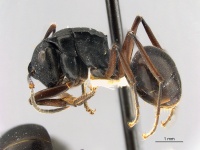Campomyrma
| Campomyrma | |
|---|---|

| |
| Polyrhachis creusa | |
| Scientific classification | |
| Kingdom: | Animalia |
| Phylum: | Arthropoda |
| Class: | Insecta |
| Order: | Hymenoptera |
| Family: | Formicidae |
| Subfamily: | Formicinae |
| Tribe: | Camponotini |
| Genus: | Polyrhachis |
| Subgenus: | Campomyrma Wheeler, W.M., 1911 |
| Type species | |
| Polyrhachis clypeata (junior synonym of Polyrhachis exercita) | |
| Diversity | |
| 60 species
| |
This is currently a subgenus of Polyrhachis. Please see Polyrhachis for further information.
Species Groups
- The gravis species-group and a key to species.
- The micans species-group and a key to species.
- The xiphias species-group and a key to species.
Nomenclature
The following information is derived from Barry Bolton's Online Catalogue of the Ants of the World.
- CAMPOMYRMA [subgenus of Polyrhachis]
- Campomyrma Wheeler, W.M. 1911c: 860 [as subgenus of Polyrhachis]. Type-species: Polyrhachis clypeata (junior synonym of Formica exercita), by original designation.
Kohout (2013) - The subgenus Campomyrma was established by Wheeler (1911) as a replacement of the Emery's (1896) 'cohors Polyrhachides camponotiformes'. He designated Polyrhachis clypeata Mayr 1862 (=Polyrhachis exercita Walker, 1859) as the type species, but did not provide a description of the subgenus. Forel (1915) elaborated on Emery's classification by subdividing several of the Polyrhachis subgenera established by Wheeler. Within the subgenus Campomyrma he included Emery's manipulus clypeata and manipulus femorata, but excluded manipulus thrinax which he formally established as subgenus Myrmothrinax. A description of Campomyrma was eventually provided by Emery (1925), who also subdivided the subgenus into two species-groups, with most species included in the clypeata-femorata group and two species from south-east Asia placed in the halidayi-group. An additional, inconspicuia-group, was listed by Andersen & Burbidge (1991), but the authors did not give any further details. Later, Andersen (2000) recognised six species groups within Campomyrma - creusa, gravis, inconspicua, micans, schwiedlandi and 'Group A', most of them pertinent to the monsoonal and arid zones of northern Australia. He provided a key for their separation and portrayed three of these groups (gravis, micans and schwiedlandi) as composed of 'some of the most spectacular-looking of all Campomyrma.' Andersen (2000) characterized the species comprising the gravis-group as 'hairy and conspicuously striate species (although often rather shiny), often with contrasting reddish legs. They typically have a scale-like petiolar node, with four erect, approximately equal teeth or small spines'. Two exceptions are P. pseudothrinax Hung, 1967 and P. unicornis sp. nov., described below, both featuring a Myrmothrinax-like petiole with a single, long, central spine. Besides P. gravis Clark, 1930 and P. pseudothrinax, the gravis-group presently includes 8 newly described, closely similar species differentiated mostly by the sculpturation of the mesosoma and the configuration of the petiolar spines. Most species of the group are relatively rare, with many known only from a short original series or single specimens collected during recent environmental surveys of poorly known and isolated parts of the country. Andersen (2000) characterised species of the micans-group as 'easily recognised by their Myrma-like petiole, with a central pair of long, sharp spines'. The only relatively common species of this group are P. micans Mayr, 1876 and P. prometheus Santschi, 1920, the latter also being the most widespread species of the group. As perceived here, the micans-group includes the two latter species, the recently described P. incerta Kohout, 2008 and two new species described below. The third, schwiedlandi-group, according to Andersen (2000), is 'extremely rich' in species which are 'distributed primarily throughout the arid zone'. It includes rather 'large, bulky species with highly distinctive, curled petiolar node, with strongly curved carinae running between the central and lateral teeth' (Andersen, 2000). The taxonomy of the schwiedlandi-group will be dealt with in a separate paper. While this framework is being followed here, it is anticipated that further studies on this subgenus will result in refinements and changes to the groups recognised by Andersen (2000). This will be undertaken in a future study.
References
- Bolton, B. 2003. Synopsis and Classification of Formicidae. Mem. Am. Entomol. Inst. 71: 370pp (page 123, Campomyrma as subgenus of Polyrhachis)
- Cantone S. 2018. Winged Ants, The queen. Dichotomous key to genera of winged female ants in the World. The Wings of Ants: morphological and systematic relationships (self-published).
- Emery, C. 1925d. Hymenoptera. Fam. Formicidae. Subfam. Formicinae. Genera Insectorum 183: 1-302 (page 178, Campomyrma as subgenus of Polyrhachis)
- Forel, A. 1917. Cadre synoptique actuel de la faune universelle des fourmis. Bull. Soc. Vaudoise Sci. Nat. 51: 229-253 (page 251, Campomyrma as subgenus of Polyrhachis)
- Jaitrong, W., Yamane, S., Samung, Y., Noon-anant, N. 2023. The ant subgenus Campomyrma of the genus Polyrhachis Smith, 1857 (Hymenoptera, Formicidae, Formicinae) in Thailand and Laos, with descriptions of two new species. Zootaxa 5271(2), 294–312 (doi:10.11646/zootaxa.5271.2.5).
- Klimeš, P., Drescher, J., Buchori, D., Hidayat, P., Nazarreta, R., Potocký, P., Rimandai, M., Scheu, S., Matos-Maraví, P. 2022. Uncovering cryptic diversity in the enigmatic ant genus Overbeckia and insights into the phylogeny of Camponotini (Hymenoptera:Formicidae:Formicinae). Invertebrate Systematics, 36(6), 557-579 (doi:10.1071/is21067).
- Kohout, R.J. 2013. A review of the Polyrhachis gravis and micans species-groups of the subgenus Campomyrma Wheeler (Hymenoptera: Formicidae: Formicinae). Memoirs of the Queensland Museum, Nature 56, 92-117.
- Robson, S. 2020. Spiny Ants (Polyrhachis). Encyclopedia of Social Insects, pp. 1–6. (doi:10.1007@978-3-319-90306-4_115-1).
- Wheeler, W. M. 1911c. Three formicid names which have been overlooked. Science (N. Y.) (n.s.) 33: 858-860 (page 860, Campomyrma as subgenus of Polyrhachis)
- Wheeler, W. M. 1922i. Ants of the American Museum Congo expedition. A contribution to the myrmecology of Africa. VII. Keys to the genera and subgenera of ants. Bull. Am. Mus. Nat. Hist. 45: 631-710 (page 702, Campomyrma as subgenus of Polyrhachis)

